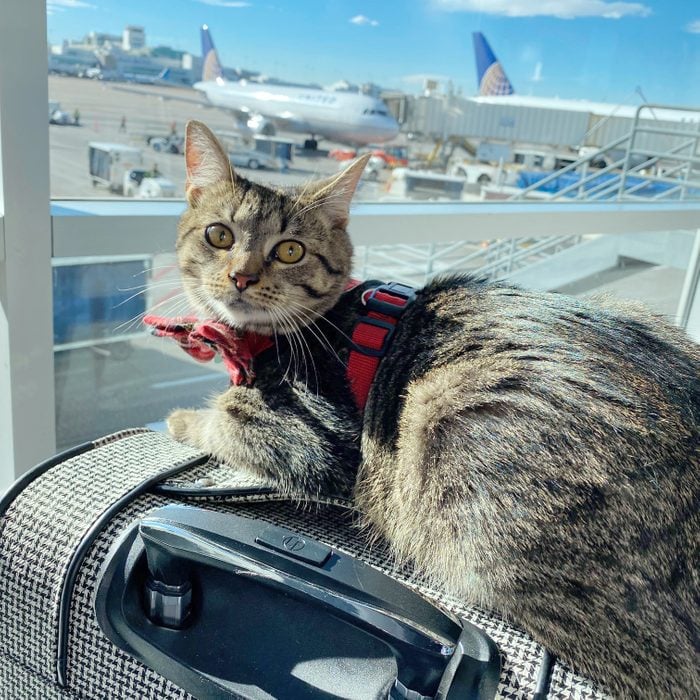
How to fly with a cat
One of the qualities we adore about cats is their independence. Still, as self-reliant as they are, we wouldn’t dream of leaving our little lions at home when it’s time to visit family and friends across the country.
Flying with a cat is a bit different from flying with dogs. Before our kitties can earn their wings, managing their air travel and finding the best airlines for traveling with pets is key to flying with less stress. It’s wise to help your cat prepare for all the nuances of travel weeks before the trip and have contingency plans for unforeseen delays or a canceled flight.
“With a little preparation, flying with a cat can be a pleasurable experience rather than a stressful and scary nightmare,” says Jeff Smith, DVM, a veterinarian at Danville Family Vet in Danville, Virginia.
Ready to learn how to fly with a cat? We asked veterinarians, a cat expert and a cat parent who flies with her cat for their best tips.
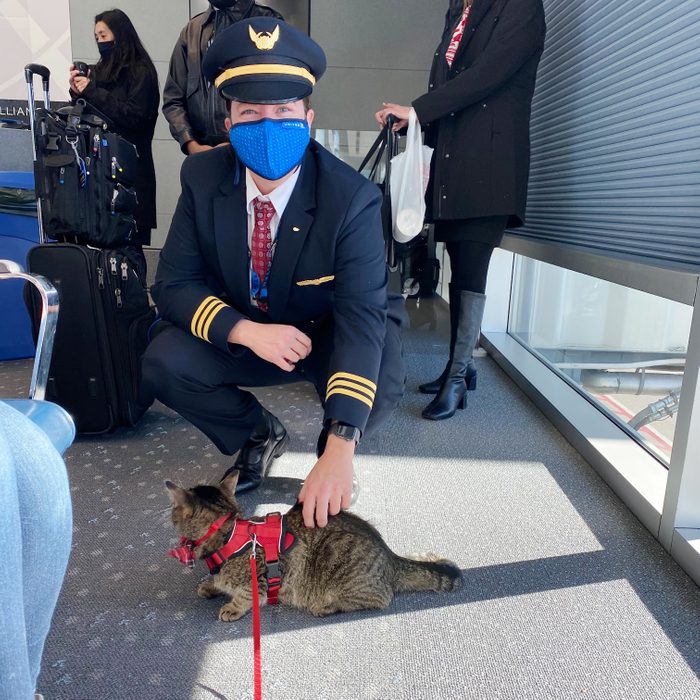
Is it safe for cats to fly on airplanes?
Overall, it is safe for cats to fly on an airplane. However, if your cat has specific medical conditions, check in with your vet a couple of weeks before booking a flight. You’ll also want to check the airline policy to see if your cat’s specific breed is on the “no-fly” list, mainly brachycephalic cats of any “mix,” such as the Burmese, Persian, Himalayan and Exotic Shorthair, says Marc Bordelon, DVM, a veterinarian with Dutch telemedicine for pets. These short-headed brachycephalic cat breeds are more prone to respiratory problems in general; adding the stress and anxiety of air travel can make breathing even more difficult.
Additionally, pressure changes at altitude can hurt cats’ ears, similar to how your own ear might pop, says Dr. Smith. Because of this, he recommends that your cat travels with you in the cabin, rather than in the cargo hold. Though cargo areas are pressurized, the temperatures can vary. Plus, animals that fly in the live cargo hold need to be checked in hours before the flight, then there’s the transfer from the staging area to the plane, which could be long and very stressful for your cat. When your cat flies with you in the cabin, you have easy access to monitor and comfort them right at your feet.
About that ear pressure: Dr. Bordelon says there isn’t much research on releasing the pressure in your cat’s ears, but offering them a little treat on takeoff and landing might help to relieve the discomfort with ear popping.
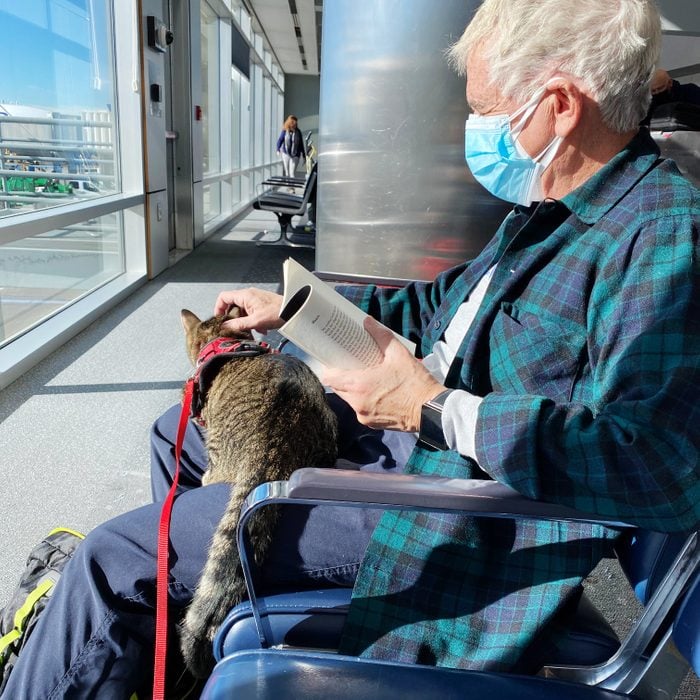
How much does it cost to bring a cat on a plane?
Even though your little lion doesn’t take up much space stowed under the seat, flying with a cat isn’t free—fees vary depending on the airline. Be sure to check with your airline if the fee is refundable should you change plans. Here is what it costs to bring a cat on a plane from these popular airlines:
| Airline | Cost | Extras |
| American Airlines | $125 each way | If your itinerary includes a voluntary stopover/connection of more than 4 hours, fees apply for each connection segment. |
| Delta Airlines | $95 each way | |
| JetBlue | $125 each way | TrueBlue members earn 300 extra points per segment for adding a pet to their booking. |
| Southwest Airlines | $95 each way | Pet fare is refundable if you cancel your reservation or if your flight is canceled. |
| United Airlines | $125 each way | Plus an additional $125 for each stopover of more than 4 hours within the U.S. |
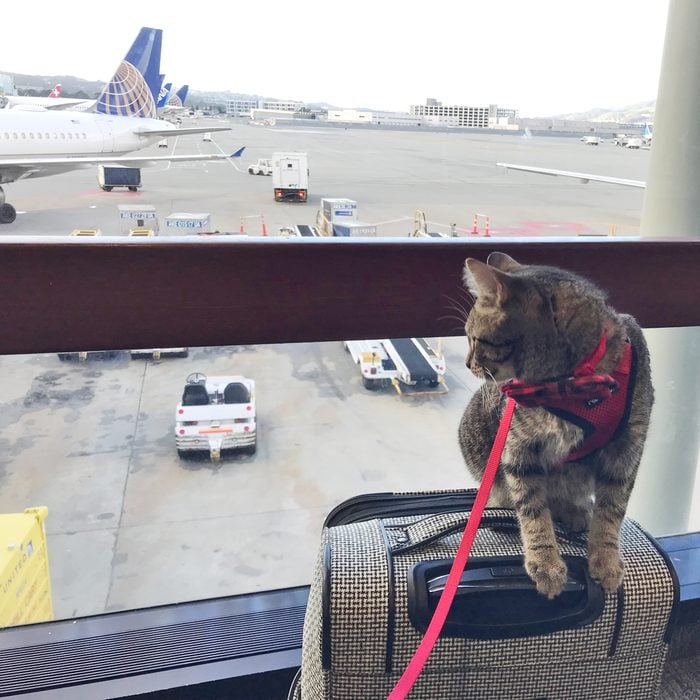
What steps should you take before you book a flight?
1. Check on airline policies
Although you can’t buy a seat for your cat, you’ll still need a reservation for them to fly in the carrier. Airlines offer a limited number of pet reservations for the cabin, so book early. Pet policies, such as carrier size, age and breed requirements vary depending on the airline. Plus, some airlines don’t accept brachycephalic cat breeds. To choose the best airline for you and your kitty cat, visit the pet policy section of the airline website.
2. Talk to your vet
If your cat hasn’t visited the vet in a while, getting a checkup for the health document is essential. And you want to ensure it’s safe for your cat to fly, especially if it has been showing signs it might be sick. “Like humans, certain medical conditions could be more concerning, but your vet will know if those are a factor for your cat and what can be done for their benefit,” says Dr. Smith. This is also a good time to ask about ways to calm your cat’s anxiety. Your vet may prescribe anti-anxiety medication or pheromones to help calm your cat’s frazzled nerves.
3. Request medical records
Ask your vet what specific health documents you’ll need for your destination. “You typically always need a health certificate. This can be very, very involved if traveling internationally or outside the contiguous U.S.,” says Dr. Bordelon. Get a printout and/or digital records with updated vaccine records and health certificates to have handy for travel days.
4. Buy the right size pet carrier
Your current cat carrier may be perfectly suitable for your needs, but you should measure the dimensions to ensure they meet the airline requirements, which can vary even within the airline. For instance, on American, a mainline flight specifies the carrier be 19 x 13 x 9 inches. Yet carriers should be 16 x 12 x 8 inches for regional flights on their American Eagle jets. JetBlue and Southwest sell approved carriers on their website if you don’t want to bother with finding the right size.
5. Help your cat get comfy with their carrier
If your cat’s only experience with cat carriers was a horrific stressfest when you took them to the vet, it’s prudent to know how to get your cat in a carrier gently long before your flight. Your kitty should feel like the carrier is a cozy and safe hangout. “I leave a cat carrier out in my home 24/7 so it’s part of the cats’ environment, versus something that only comes out for ‘scary’ reasons,” says Samantha Bell, cat expert for Best Friends Animal Society. Once they’re comfortable getting in the carrier, try closing the carrier door for a few seconds and rewarding them, working up to more time in the closed carrier.
6. Train your cat to wear a harness
Cats can slip out of a collar, and attaching a leash to a collar could hurt their throat when they pull. A harness is a better option to keep your kitty safe and comfortable while walking. Fair warning: Your cat will probably hate it at first. You can tell by observing your cat’s body language. They might run off and hide or refuse to move while the harness is on. That was the experience for Elainna Coelho, who is a frequent flyer with her cat D’Artagnan. (That’s D’Artagnan featured in all the photos in this article.) “The first month of harness training, I was gently pulling him around and bribing him with treats,” says Coelho. With consistent training, he eventually got used to his harness ahead of the flight and now enjoys exploring while at home or at an airport terminal.
7. Introduce the concept of traveling
Long before flying with a cat, it’s wise to expose your little lion to the various elements they will experience while traveling. “I think this is so important, because if you don’t slowly introduce people, noises and smells, it will be very overwhelming for the cat, especially if they are timid,” says Coelho. Start with short car trips and work your way up to longer trips. Add stops at the park, pet store and a friend’s house.
8. Ensure your cat has a permanent I.D.
Since your cat isn’t flying in the cargo area, you’re not likely to lose them while they’re secured in their carrier by your feet. Still, it’s best to verify the details on your pet’s I.D., whether it’s an I.D. tag, microchipping or GPS tracking device, should your cat go missing while at the airport or during your stay.
9. Adjust your cat’s feeding schedule
If you’re worried about your cat’s feeding schedule getting disrupted, you can start adjusting the schedule to match flight day about a week ahead of time, Bell says. “In my experience flying with cats, they weren’t hungry during the flights, so don’t be alarmed if your cat waits to eat hours after they’ve landed.”
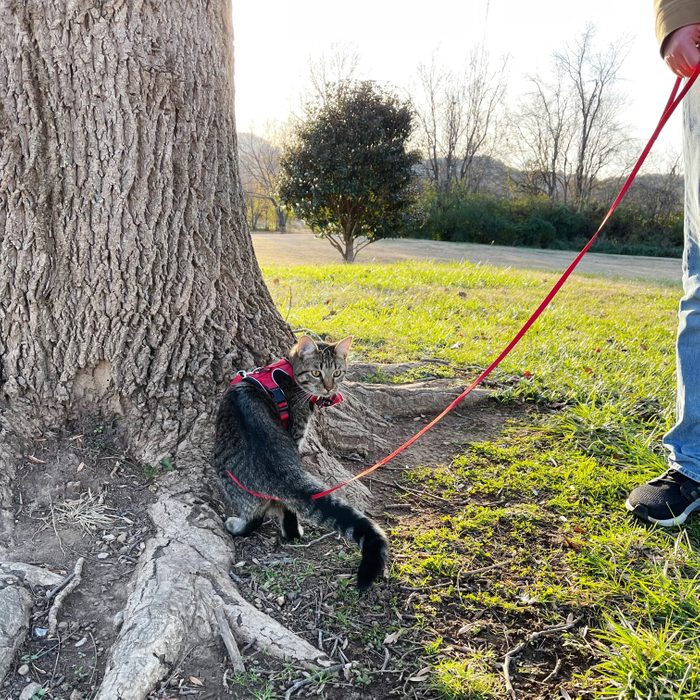
What steps should you take the morning of your flight?
1. Don’t feed your cat
It might seem heartless, but you’ll be doing your cat’s stomach a favor by withholding their breakfast before your flight. “Cats with an empty stomach are less likely to vomit,” Dr. Smith says. (If your flight is later in the day, their last meal should be about six hours before flying). Keep a snack bag of cat food and treats handy to give on the plane or in case of long delays. And don’t forget to pack a spill-proof bottle and offer water frequently throughout the trip to avoid dehydration.
2. Keep calm and try pheromones
Travel days are hectic enough without starting on the wrong paw. Get organized the night before, and avoid frantically looking around for those last-minute items to stash in your suitcase. “Try to stay calm, as cats can pick up on our energy. If you’re frazzled, your fur baby will be too,” says Coelho. Even if you’re cool as a cucumber, your kitty may still need a little more help relaxing. “I recommend using Feliway spray and dousing a towel that stays with your pet, and then using the Feliway wipes to coat every inch of the carrier, and reapply if needed halfway through the flight,” says Dr. Bordelon.
3. Give meds if needed
Prescription anxiety medications can work for cats that may need a little more help. “Gabapentin has a good mix of anxiety relief and sedation for cats that need to travel,” says Dr. Smith. If your cat has had bouts of vomiting while traveling in the past, Dr. Bordelon recommends Cerenia to help prevent vomiting on the plane.
4. Stash comfort items in the cat carrier
Place your cat’s favorite blanket, toys and other comfort items in the carrier. “The more items that have their scent on them, the better,” says Bell. Speaking of comfort, your cat may prefer a hands-off approach instead of a snuggle on travel day. Stash a lightweight blanket to drape over the carrier to reduce stimuli during the trip. Stock the carrier with extra potty pads, a bit of litter and disposable gloves for clean-up.
5. Get to the airport early
Harness your cat and place them in the carrier before you leave home. It’s going to take a bit longer getting through TSA with a cat, and the last thing your cat needs is the stress of a mad dash to the airport. Coelho recommends arriving an hour and a half before a flight, and at least two and a half hours before a flight during the holiday season.
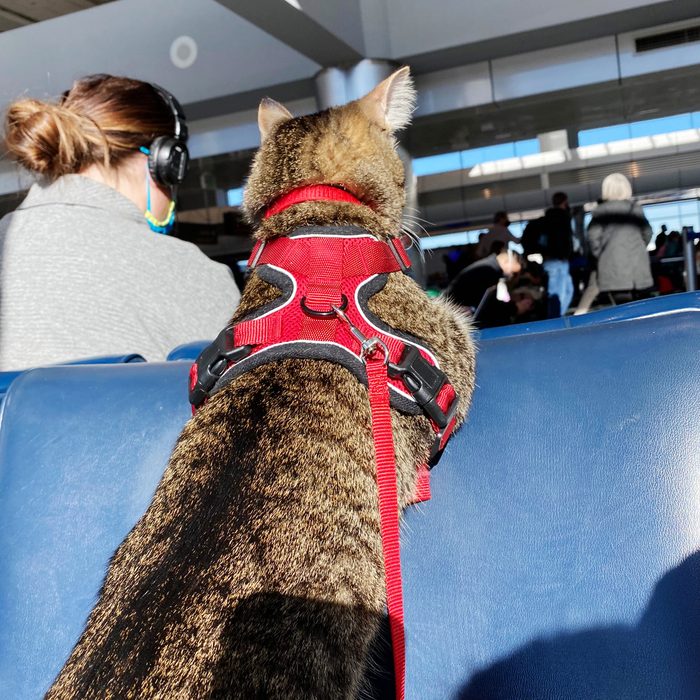
What steps should you take at the airport?
1. Talk to your cat
“I know this sounds odd, but acknowledging and assuring your cat that everything is OK is important,” says Coelho. If your cat is harness trained, let them out of their carrier to sniff around and adjust to their surroundings. If you sense your cat is cranky and they would rather stay hidden in the carrier, that’s OK too. Try putting the carrier on your lap and talking softly to them.
2. Get cat and carrier ready for TSA
Though TSA policies are generally universal, each airport has its own process and quirks. Here’s how the process generally unfolds:
“You will have to take your cat out of the carrier and remove their leash before the carrier goes through the x-ray machine. Then you’ll hold your cat in your arms as you walk through the metal detector,” says Bell. Since nervous cats may flee as soon as the carrier door opens, Bell deliberately leaves the leash on her cat with just the end of the leash out of the carrier. When she opens the carrier, she can get a good grip on the leash and secure her cat in her arms before removing the leash.
Coelho tucks D’Artagnan’s head between her arm and body when walking through security. “The clashing of plastic tubs scares him, so I tuck his head to help calm him down.”
3. Ask for a private TSA screening
If your cat is incredibly anxious in new situations and you’re worried you won’t be able to hold your cat safely, you can ask TSA for a private room for the screening. “While this allows you to keep your cat in an enclosed space, it will take quite a bit of extra time, so be sure to plan ahead for that,” says Bell.
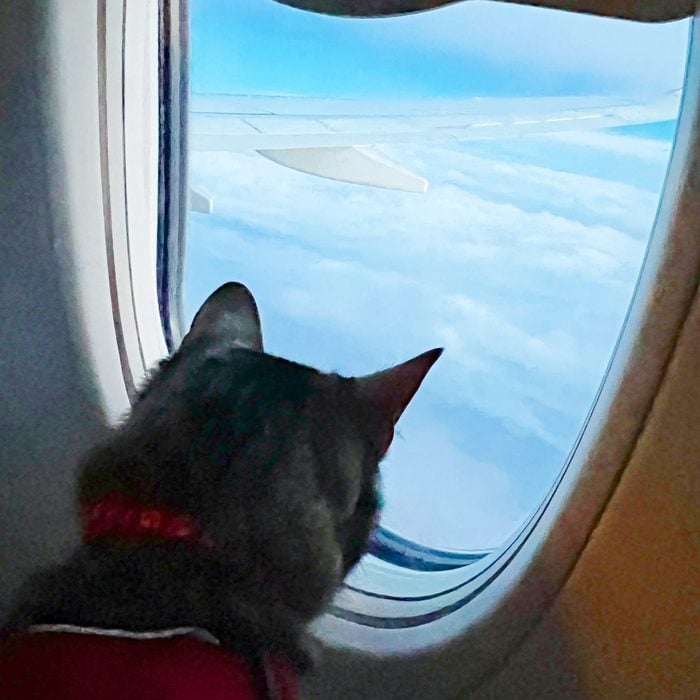
What do cats do on a plane?
Ideally, your cat will chill and nap during the flight. When your cat isn’t happy, you want to snuggle and comfort them, but all airline policies clearly state that cats must stay in their carrier while in the cabin. On one flight, D’Artagnan was loudly expressing his discontent. “It was heartbreaking,” Coelho says. She took him out of the carrier. (She had permission from her seatmate and the flight attendant.) “I pulled him onto my lap, gave him tuna paste and offered him some water. He also got hugs and kisses, and I let him sniff around and look out the window.” When she tried this approach on another airline, she was asked to put D’Artagnan back in his carrier, so she took the carrier to the bathroom to console him.
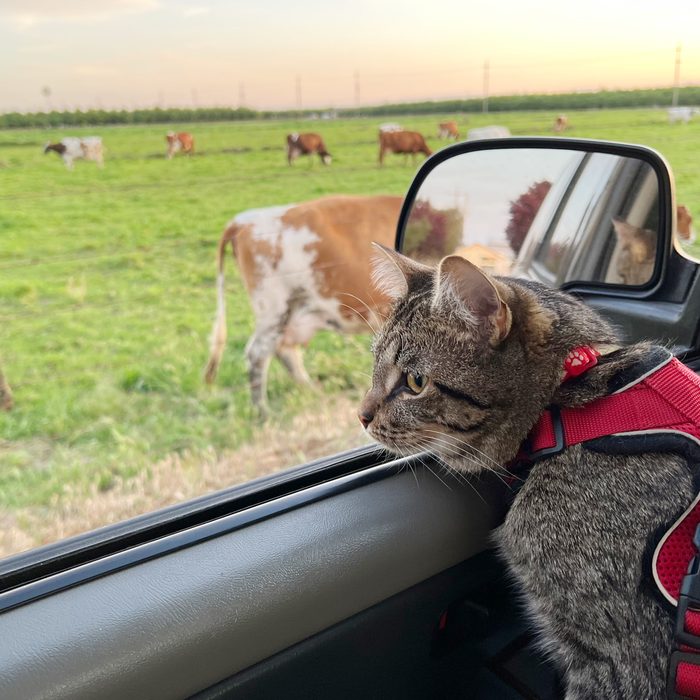
What steps should you take when you arrive?
1. Take a comfort break
Depending on the nature of your cat, you may want to let them out of the carrier after you land, especially if you have to travel in a car for a while to get to your final destination. Find a quiet area where they can stretch their legs and sniff if they’re interested. Cats are persnickety about going potty in strange places. If they didn’t while in their carrier on the plane, you could try the airport bathroom. Don’t be surprised if they hold it until you reach your final destination.
2. Acclimate to new surroundings
Now that you know how to fly with a cat successfully, you can both finally relax at a pet-friendly hotel or friend’s guest room. Since traveling can be very disruptive to a cat, unpack your cat’s essentials as soon as possible so they can get back to a sense of normalcy. “The very first thing would be to get their litter tray and food station set up and introduce them to their new place,” says Coelho. Your cat might explore their new space or choose to hide for a bit. Don’t take it personally if your cat is mad at you. Let them acclimate at their own pace. Eventually, they will eat, go potty and snuggle with you.
Get Reader’s Digest’s Read Up newsletter for more humor, cleaning, travel, tech and fun facts all week long.
Sources:
- Jeff Smith, DVM, Danville Family Vet, Danville, Virginia
- Marc Bordelon, DMV, vet specialist at Dutch telemedicine for pets
- Samantha Bell, cat expert at Best Friends Animal Society
- Elainna Coelho, cat parent of D’Artagnan
